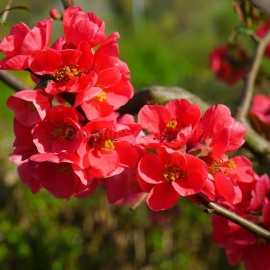









Organic Japanese Quince Seeds (Chaenomeles Japonica)
1.14 €
It is best known for its colorful spring flowers of red, white, pink or multi. It produces apple-shaped fruit that are a golden-yellow color containing red-brown seeds. The fruit is edible but not as well known for its jelly and pie.
-
Organic Japanese Quince (Chaenomeles Japonica)
Chaenomeles japonica is a species of Japanese Quince . It is a deciduous shrub. The fruit is called Kusa-boke (草木瓜 , Kusa-boke) in Japanese.
It is best known for its colorful spring flowers of red, white, pink or multi. It produces apple-shaped fruit that are a golden-yellow color containing red-brown seeds. The fruit is edible but not as well known for its jelly and pie making as its cousin Cydonia . C. japonica is also popularly grown in bonsai.
How to Grow
Japanese Quince seeds contain a moderate dormancy within them which requires a degree of patience to overcome. To enable this dormancy to be broken down please use the following information as a guide.
First prepare a free draining substrate into which the seeds are to be mixed, this can be a 50/50 mixture of compost and sharp sand, or perlite, vermiculite or even just pure sharp sand has worked well for me. The chosen substrate needs to be moist (but not wet), if you can squeeze water out of it with your hand it is too wet and your seeds may drown and die. Mix the seeds into the substrate, making sure that their is enough volume of material to keep the seeds separated.
Place the seed mixture into a clear plastic bag (freezer bags, especially zip-lock bags are very useful for this -provided a little gap is left in the seal for air exchange) If it is not a zip-lock type bag it needs to be loosely tied. Then write the date on the bag so that you know when the pretreatment was started.
The seeds require a cold period to break the dormancy that is naturally found within them, this is easily achieved by placing the prepared bag of seeds and compost mix in the fridge (4 Celsius or 39F) for between 4 and 6 weeks. It is quite possible for the seeds to germinate in the bag at these temperatures when they are ready to do so, if they do, just remove them from the bag and carefully plant them up.
When the period of pre treatment has finished the seed should be ready to be planted. Small quantities can be sown in pots or seed trays filled with a good quality compost and cover them with a thin layer of compost no more than 1cm (half an inch) deep. For larger quantities it is easiest to sow the seeds in a well prepared seedbed outdoors once the cold pretreatment has finished and wait for the seedlings to appear.
Seeds that are ready to germinate will be plump and soft, if they are not, the pretreatment is not yet complete or may have been ineffective due to incorrect temperatures or incorrect moisture content of the pretreatment medium.
Do not expose newly sown seeds to high temperatures (above 25 Celsius) otherwise a secondary dormancy may be induced and the seeds will not germinate until they have been pretreated again. Germinated seeds can be planted in pots or plug trays in a good quality compost. Keep the seedlings well watered and weed free. Growth in the first year is usually between 10 and 20cm and usually trouble free. Allow them to grow for 2 or 3 years before planting them in a permanent position.
